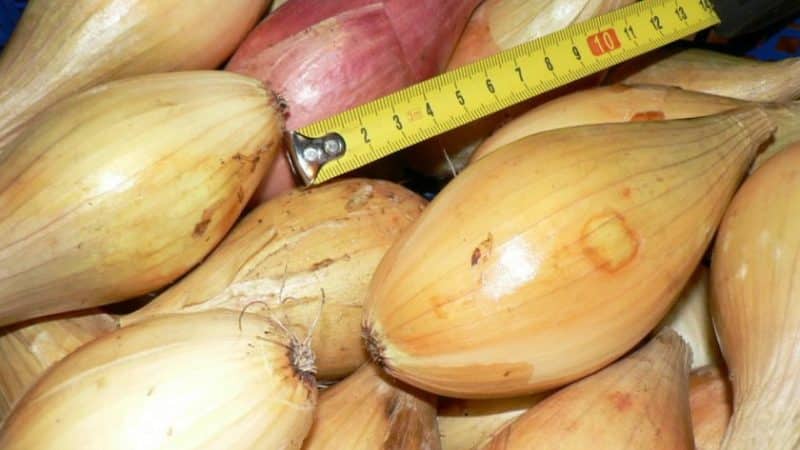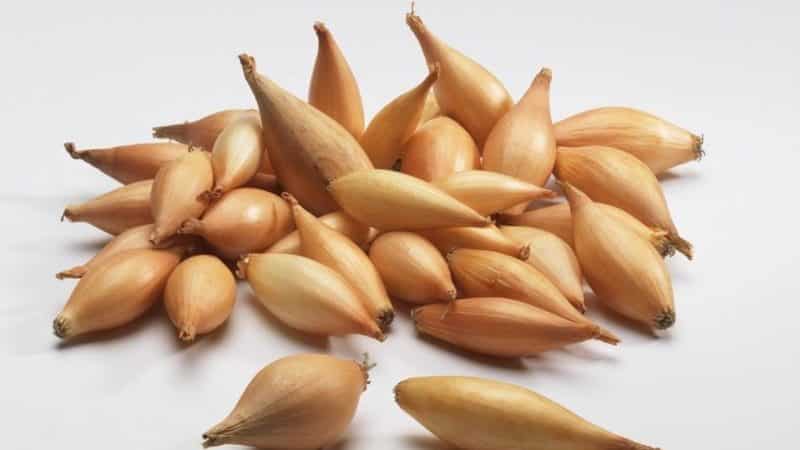High-yielding onion variety, resistant to diseases and pests “Bamberger”
Bamberger is a mid-season onion variety. It was brought to Russia from Holland and quickly became popular among local farmers due to its high yield without specific care requirements, excellent taste and universal use.
Description of the variety
The Bamberger variety is characterized by an elongated bulb shape, mild taste and bright aroma. This onion can be eaten fresh, added to hot dishes, salads and preserves.

Origin and development
Bamberger onion was developed by Dutch agronomist breeders. This is a relatively young variety - it began to be actively cultivated only in the 21st century.
Chemical composition, trace elements and vitamins, beneficial properties
Onions contain:
- proteins fats carbohydrates;
- mono- and disaccharides;
- alimentary fiber;
- vitamins A, C, E, PP and group B;
- essential oils;
- potassium, calcium, phosphorus, iron, fluorine;
- flavonoids with antioxidant effects.
The vegetable is healthy at colds, because it is able to fight inflammation and destroy bacteria, has a beneficial effect on blood vessels and blood composition, helps strengthen the intestines and helps in treatment liver.
Ripening time and yield
Medium early variety. The crop is ready for harvest approximately 90 days after planting, i.e. in late August or early September.
The maximum Bamberger yield is observed when planting onion sets - from 1 sq. m harvest about 6 kg.
Disease resistance
The variety is resistant to:
- powdery mildew;
- rot;
- thrips;
- onion nematode and flies.
Dutch onion sets have high immunity, but planting material from Chuvashia is less resistant to diseases, pests and frost, although it costs less.
Characteristics of the bulb, description of appearance, taste
The bulbs are elongated, slightly elongated, small - they grow up to 10 cm in length and weigh on average 60-80 g. They are covered with a yellow-brown husk. The pulp is snow-white, juicy with a slightly sweet, but not cloying taste. The heat is more in the aroma than in the taste.

Regions for cultivation and climate requirements
The Bamberger variety is unpretentious to climatic conditions and is successfully cultivated in almost all regions of the country.
Advantages and disadvantages
The main advantages of the variety:
- long-term storage;
- high productivity;
- ease of care;
- resistance to diseases and pests;
- versatility of use;
- soft, sweetish taste;
- lack of shooting;
- opportunity growing in various climatic conditions.
Flaws:
- tendency to shed husks during storage;
- acrid smell.
Difference from other varieties
Comparative table of Bamberger with other onion varieties:
| Variety | Ripening period | Bulb shape | Taste | Bulb weight, g | Productivity, kg/sq. m |
| Bamberger | About 90 days | Elongated, slightly elongated | Sweetish | 60-80 | 6 |
| Chalcedony | 110-120 days | Round | Spicy | 90-130 | 2-6 |
| Alvina | 95-105 days | Flat | Peninsular | 60-80 | 1,5-3 |
| Lugansk | 120-130 days | Round-oval | Spicy | 70-150 | 1,5-4,5 |
Features of planting and growing
The quality and quantity of the harvest depend on many factors, including proper preparation of planting material and soil and adherence to onion planting dates.
Pre-sowing preparation
The purchased onion sets are laid out for 2-3 weeks in a warm room at a temperature of +20...+22°C with good ventilation for drying. This helps prevent the bulbs from rotting from the inside.
To prevent bolting, destroy fungal spores that may be present on the surface, and also accelerate the formation of green leaves and roots, within 24 hours before planting the bulb warm up:
- the seed is placed in a container of suitable volume;
- pour water heated to +35…+40°C;
- close the container with a lid, wrap it up and leave for 5-6 hours.
Reference. For additional disinfection, the seedlings are soaked for 20-40 minutes in a solution of potassium permanganate or copper sulfate.
The soil is prepared with autumn: cleaned of weeds, treated with copper sulfate (dilute 1 tbsp of the product in 10 liters of water and water the ground at the rate of 1-1.5 liters per 1 sq. m), and water abundantly before frost.
In spring, the soil is fertilized. Mineral or organic fertilizers are chosen depending on the type of soil:
- loams: 3-4 kg of humus, 5 kg of peat, 2 tbsp. l. superphosphate and 1 tsp. urea per 1 sq. m;
- clay soil: 6 kg of humus and peat, 1 tsp. urea and 1 tbsp. l. superphosphate per 1 sq. m;
- peat bogs: 5 kg of compost or humus, 1 tsp. urea and 1 tbsp. l. "Nitrophoska" and superphosphate per 1 sq. m;
- sandstones: 10 liters of compost or humus, 2 tbsp. l. superphosphate, 1 tbsp. l. "Agricola" and 20 liters of loamy or clay soil per 1 sq. m.
The beds are dug up using a spade, then covered with film and left for 5-6 days.
Soil requirements
Bamberger prefers light, fertile soil with good aeration and moisture permeability. Permissible acidity for mineral soil is pH 6.5-7, for peat soil - 5.5-6.5.
Dates, scheme and rules of planting
There are two options for planting Bamberger sets: subwinter (in the third ten days of October) and spring, when the soil warms up to +10°C (in mid-April - early May).
- Prepare the beds at a distance of 25-30 cm from each other.
- Make planting furrows 8-10 cm deep in them.
- Place the bulbs in the furrows so that the distance between them is approximately 10 cm.
- With the onset of stable frosts, cover the beds with a thick (10-15 cm) layer of hay, straw, fallen leaves or sawdust.
After the snow melts, the mulch layer is removed from the garden bed. This is usually done in the second ten days of March, but if frosts continue, the mulch is left until they pass.
When the soil dries, it is loosened. Soon after this, onion feathers appear from the ground.
For spring planting, dig up the soil with half a shovel and level it with a rake. Next you need:
- Prepare beds with a distance of 25-30 cm between them.
- Make planting furrows 3-5 cm deep in them.
- 30 minutes before planting the seedlings, water the furrows (1 liter of water per 1 m of furrow).
In the spring, you can also sow onion seeds by first soaking them for a day in a solution of a growth stimulator, for example, Epin.
Features of cultivation
The place for planting Bamberger onions should be well lit, protected from gusty winds and located on a slight hill. Moisture often stagnates in lowlands, which causes the bottom of the onion to rot.
It is important to take into account the rules of crop rotation: the best predecessors of onions are peas, soybeans, beets, cabbage and grains.
Reference. Onions can be planted in the same place once every 3-4 years.
Bamberger onions are easy to care for.At the same time, it needs to comply with basic agrotechnical norms and rules in the same way as other varieties.
Watering mode
The need for irrigation is determined by the condition of the soil: water when it is completely dry to a depth of 10 cm.
The procedure is carried out in the morning, since during evening watering the onions will not have time to dry completely, and the accumulation of moisture on the leaves leads to the development of fungal diseases.
Particularly abundant watering - every 2-3 days - is required during the month of cultivation. Then it is gradually reduced - to 1 time every 10 days. 2-3 weeks before harvesting, they stop completely so that the onions ripen well.
Loosening the soil and weeding
The soil is loosened and weeded every 10-14 days or more often. It depends on the growth rate of the weed.
Loosening improves oxygen access to the bulbs, which has a positive effect on the quality and quantity of the harvest. Removing weeds is necessary to prevent them from taking nutrients from the soil.
Important! Beds covered with mulch do not need these procedures.
Top dressing
Fertilizers are applied three times according to the following scheme:
- 14 days after planting the onions - a solution of chicken manure at the rate of 10 liters per 1 sq. m;
- after 3-4 weeks – nitrogen-containing fertilizers;
- after another 3-4 weeks - potash fertilizers.
Disease and pest control
To prevent the development of diseases and pest attacks, plants should be treated with copper oxychloride during active growth or with copper sulfate when the length of the feathers reaches 15-20 cm.
Difficulties in growing
When cultivating this variety, the following problems may arise:
- release of seed shoots when planting onions in cold soil;
- drying and lodging of feathers due to non-compliance with the rules of agricultural technology (shallow planting of seedlings, lack of nitrogen in the soil, lack of lighting);
- yellowing and drying of leaves due to attack by onion flies.
Harvest and storage

The ripening of onion heads is indicated by the lodging of feathers.
How and when to collect
The harvest is harvested in August - September, carefully digging up the bulbs with a shovel and removing them from the ground with your hands.
Storage features and keeping quality of the variety
After harvesting, the onions are dried in a well-ventilated area at an air temperature of +30°C.
After drying, cut off the roots and carefully inspect the bulbs: those that are too small are set aside for early use, and those that are spoiled are thrown away.
For storage, onions are placed in wooden or plastic boxes with holes for ventilation, wicker baskets or mesh bags and taken out to a dark, ventilated room where the humidity is 70% and the air temperature is +3...+10°C.
Important! Containers with onions are placed on shelves or pallets. Do not store crops on the floor or near walls.
If the necessary conditions are met, onions are stored until a new harvest, practically do not deteriorate and do not germinate.
Advice from experienced gardeners
Farmer tips for growing Bamberger:
- Cover the soil between the rows with mulch. This will help avoid damage to the bulbs and leaves when cultivating the soil and minimize the risk of developing certain bacterial diseases.
- Cover newly planted plants with agrofibre or spunbond - this will keep them warmer. In addition, the non-woven material hides the smell of onions from pests.
- Plant carrots nearby - they repel onion pests.
Reviews of the Bamberger onion variety
You can get a more realistic idea of Bamberger onions by reading reviews from gardeners.
Maria, Tula: “I don’t like bitter onions, so I was looking for a variety with a sweet taste. Another selection criterion was high yield with minimal care, since I can only go to the dacha on weekends. In the end, I settled on the Bamberger variety and did not regret it; I have been growing it for 5 years. I like that it is unpretentious and productive, and it can be stored perfectly – almost until the next harvest without loss of taste.”
Timofey, Bryansk: “I have a lot of experience as a gardener; I have grown many different varieties of onions, so I have something to compare with. I can say for sure that even a complete beginner can cope with Bamberger - the variety is not capricious, it grows almost on its own, and the yield is excellent. I experimented with the time of planting - the winter one tastes much better.”
Conclusion
Bamberger is a mid-early ripening onion variety. During breeding, agronomists managed to strengthen its resistance to diseases, bolting and pests. This onion has a good taste, a long shelf life and does not require labor-intensive care. Suitable for cultivation in all regions of Russia.
